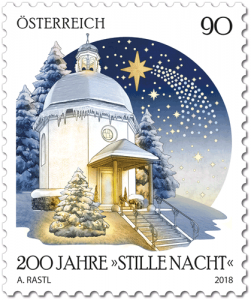
I’ll begin the story of Silent Night with a happy reminiscence. Recently, a Viennese friend sent us a Christmas card. We had visited him in Vienna the summer before, and had Kaffee und Kuchen together, as he showed us all round his wonderful city. His Christmas card had a stamp showing a picture of a manger scene, with the words “200 years: Silent Night” (200 Jahre: Stille Nacht). But it’s not the only Austrian stamp like this, as we’ll see in a moment. In fact, the Austrians are immensely proud of this Christmas carol. And rightly so. Lots of folk would say that it is the greatest Christmas carol of all. It is certainly the best known. So I’ll talk about it here, and illustrate its story here in Austrian stamps.
THE TWO HUNDREDTH ANNIVERSARY STAMP
The stamp my friend sent me is for the 200th anniversary of the carol. (So I guess he bought it back in 2018.) You maybe know how the story of how Silent Night began. In the Mariapfarr church in Lungau there was a young assistant priest called Joseph Mohr. Mohr witnessed the great sufferings of the people of his Mariapfarr parish when the Bavarian occupiers withdrew in 1816 and 1817. And what he witnessed drew Mohr to write the text of his song in 1816.
The next year, Mohr became priest in the Saint Nicholas Church in Oberndorf near Salzburg. There, on the morning of Christmas Eve 1818, he asked his friend, the church organist and schoolmaster at Arnsdorf, Franz Xaver Gruber, to write a melody for the poem, arranged for tenor and bass voices and guitar. (Some say this was because the church organ was broken.) The muse obliged, and Gruber returned with the song a couple of hours later. Mohr loved Gruber’s melody and they agreed to sing it at the midnight mass. So it was that Stille Nacht or Silent Night was first sung on Christmas Eve 1818. Gruber sang the tenor melody and played the guitar and Mohr sang bass.
The building you see in the postage stamp picture is the memorial chapel to Silent Night. It was built in 1924 in the place of the Saint Nicholas Church, which was demolished after flooding in the early twentieth century.
THE STORY OF SILENT NIGHT IN TIME OF WAR
As I said, Mohr wrote the song after witnessing the sufferings of the town of Mariapfarr at the hands of the Bavarian occupation troops in 1816. The little-known fourth verse of his lyric is actually a prayer for peace.
| Stille Nacht! Heilige Nacht! Wo sich heut’ alle Macht Väterlicher Liebe ergoß Und als Bruder huldvoll umschloß Jesus die Völker der Welt, Jesus die Völker der Welt. | Silent night! Holy night! Where on this day all the power of the Father’s love poured forth And, like a brother, Jesus lovingly embraced the peoples of the world, the peoples of the world. |
Yet the most famous war story of Silent Night occurs almost one hundred years after its composition, in the miserable freezing trenches of World War One, in December 1914. The war had been four months in progress when Pope Benedict XV called for a ceasefire to honour the Christmas season. Both warring sides rejected his call. But on Christmas Eve, there was a truce after all.
It was, said Pvt. Albert Moren of the Second Queens Regiment, “a beautiful moonlit night, frost on the ground, white almost everywhere”. The trenches of the two sides were very close, so close that they could smell the enemy’s war-time cooking across No Man’s Land. All of a sudden, the men in the British trenches heard the Germans singing Stille Nacht. When they were finished, the Brits sang Silent Night, and the Germans listened. Then the Brits began singing “O come all ye faithful” and the Germans joined in, in Latin, Adeste fideles. (German education was always more scholarly than British.) Graham Williams of the Fifth London Rifle Brigade reflected to himself “Well, this is really a most extraordinary thing – two nations both singing the same carol in the middle of a war.”
PEACE IN THE TRENCHES
On Christmas Day, the story goes, the Germans emerged from their trenches shouting in English, “Merry Christmas”, and holding notices saying, “You no shoot! We no shoot!” Cautiously, men on both sides began to emerge from their trenches. They met in the middle of No Man’s Land, shook hands, shared cigarettes, and played football together. The brief peace even gave them a chance to bury dead comrades who had lain in No Man’s Land for weeks. About 100,000 men, all along the battle line, participated in this truce. In some places, it lasted as long as a week, until the New Year.
But the commanders, far from the trenches, were not at all in agreement with this fraternizing with the enemy. They had, after all, a pointless war to win. The commander of the British Second Corps, General Sir Horace Smith-Dorrien told Divisional Commanders to prohibit, on pain of death, any “friendly intercourse with the enemy”. And so hostilities resumed, ultimately claiming some 15 million lives, devastating all the countries involved.
Yet the men in the trenches had no desire to continue the fighting. One British soldier, Murdoch Wood, speaking in 1930, said: “I then came to the conclusion that I have held very firmly ever since, that if we had been left to ourselves there would never have been another shot fired.”
Want to know a bit more about the English Christmas carol tradition? See
In 2014, the truce was widely recalled as a moment of hope in time of war. That is when we started singing our quadrilingual version of Silent Night, which we first sang at the British Embassy in Brussels that year. It sounds like this.
That Christmas, the British supermarket Sainsburys, in partnership with the Royal British Legion, made this great Christmas advert.
